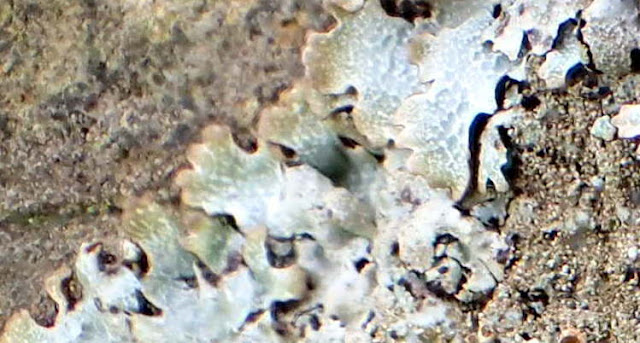On 1st January I set off to three nature reserves close to Settle to take photographs of Lichens preparing for the talk "Settle's Top Ten Lichens"
I wonder which ten lichens will be chosen? Which would you recommend?
I visited Winskill Stones (Plantlife); Malham Tarn Estate (National Trust) and Globe Flower Wood (Yorkshire Wildlife Trust)
It is the first day of our new decade (2020 01 01)
Come with me as I set forth to visit local nature reserves near Settle,
to record my first lichens for January,
complete with my poster.
First stop is Winskill Stones, 1.5 miles from Settle.
Plantlife Nature Reserve
The sun I had seen at 10am at breakfast time (late breakfast after the night before..) is now hidden by clouds at midday..

Doesn't seem two days since the sign was brand new. It has a picture of Geoff Hamilton who campaigned to save limestone pavement.
Doesn't seem two days too since I was up here with the "immortal" David Bellamy in 18 July 1998 when he came to see the reserve and make a short film for Plantlife. David died three weeks ago on 11 December 2019. No one is immortal. I did enjoy hearing him talk about the plants we found down the grykes. Memories go on.

The hole in the car park is getting bigger (see sign board in the background)

The famous view from the car park towards Lower Winskill Farm (white) in the distance. Note white flecks on the all tops.. I'll come to that later.

I see we are on the #PennineBridleWay See the route here
I (later) stand beside the wall of Winskill Stones and take a selfie.
Fountains Fell and Pen y Ghent which should be in the distance are in the clouds.

And from the same spot, looking back towards the car park (behind my red hat)

The big white patches on the pavement rocks are..
Aspicila calcarea
Yes. I like to call this "White Limestone Wall-top lichen"
Aspicila calcarea
pronounced (to help you remember it) Ass Pee Sillier
It seems to like sunlight and maybe bird droppings/ high nutrients.
-------------------------------
Next Stop three miles on: Malham Tarn: Six miles from Settle

Every space in the car park IS taken - It is bank holiday.
I walk the 200m towards the Tarn. The Malham Tarn Estate now belongs to The National Trust
En route I find

Dung Roundhead in the grass in the foreground above - my first fungus of 2020 Stropharia semiglobata .
It gets its food and therefore energy from.. Dung.
Lichens are made of Fungi too, but lichens also contain algal cells which can photosynthesise and make sugars.

On a small greywacke (siliceous rock) boulder in the same soil is a fruiting specimen of the lichen whose English name is Crottle also known as Stony Rag (Parmelia saxatilis) -
Let's look at this more closely:

 |
The grey thallus (body of the lichen) has ridges with white lines - that is what makes it Parmelia saxatilis instead of another species of Parmelia. |
 |
The older parts of the thallus have little lumps that stick up, like little fingers, or warts. They are called isidia. The isidia are covered with the skin of the thallus..
They break off and the tiny lumps (which contain both fungal threads and algal cells) blow away and land and can grow into a new lichen. This is vegetative reproduction.
Lichen keys are always asking "Does the lichen have isidia or not?
Well Parmelia saxatilis does have isidia.
|
The cups with brown centres are the fruiting bodies - called apothecia. The smooth brown part is made of fungal cells which produce tiny spores .. which blow away .. and if they are lucky enough land near a relevant alga and grow into another Parmelia saxatilis.

We approach the Tarn. The sluice gate was built first by the Ribblesdale family in the 18th C, then highered by Walter Morrison in the 19th c. - thus increasing the area of the Tarn
Where those stones in the foreground capping the stream wall are limestone, then that white lichen is Aspicilia calcarea
 |
Look at the round sandstone block in the right foreground. It has some grey-green lichen on the surface .. including under my shadow. With a hand lens you can see this lichen too has apothecia, with white rims. Today they are quite moist |
Members of the genus Lecanora have apothecia with rims like this, that look like "jam-tarts"
This lichen has a thallus that is lobed, or at least pleated. (See the lobes at the bottom right of the picture) It is not just a crust: Lecanora muralis is the only species of Lecanora that has these lobes - which makes it easy to identify
This is common on footpaths and pavements in towns.
It is called "Chewing-gum lichen"
Then it is off two miles back towards Settle to the Yorkshire Wildlife Trust Reserve (4 miles from Settle) of Globe Flower Wood


See a big white crustose lichen on the limestone wall top:
It is White Limestone Wall-top Lichen (Judith's name) Aspicilia calcarea..
Oh look - I'm still promoting the talk.









No comments:
Post a Comment